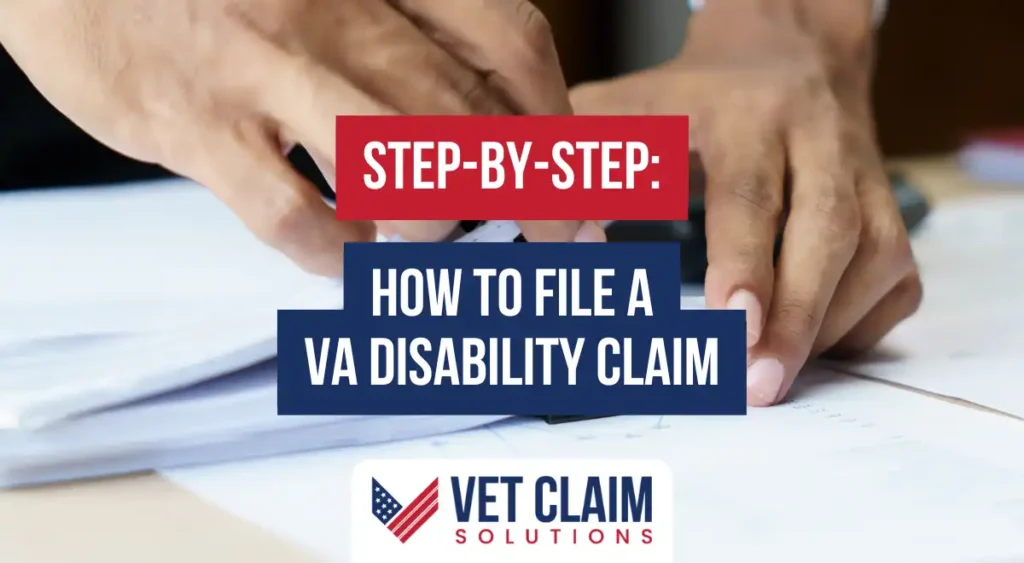This guide offers a step-by-step approach for when you need to file a VA disability claim. We cover essential topics like eligibility for VA disability benefits and the necessary VA forms. You’ll also learn how to steer clear of common mistakes during your initial filing for disability compensation.
Understanding VA Disability Claims
VA disability claims are a way for veterans to receive disability compensation for injuries or illnesses that occurred or were aggravated during active duty military service. These VA benefits can provide important financial support and access to healthcare. The core of any disability claim is proving a service connection between your current condition and your time in service.
The Department of Veterans Affairs (VA) evaluates each claimed condition. If service connection is granted, the VA assigns a disability rating. This rating, expressed as a percentage from 0% to 100%, reflects the severity of your condition and its impact on your earning capacity.
A higher disability rating generally results in a larger monthly compensation payment. If a veteran has multiple service-connected conditions, the VA uses a specific formula, often referred to as “VA math,” to calculate a combined disability rating; it’s not a simple addition of percentages. Understanding this process is a part of managing your VA disability compensation.

Eligibility for VA Disability Claims
Before you begin the process to file disability paperwork, it’s important to understand the basic eligibility criteria for VA disability benefits. Generally, you may be eligible if you meet both service and disability requirements. This includes having served on active duty, active duty for training, or inactive duty training and having a disability related to your service.
Your character of discharge is also a factor. Typically, you need a discharge under conditions other than dishonorable. This includes honorable discharges and general discharge under honorable conditions.
Finally, you must have a current physical or mental health condition that was caused or made worse by your military service. This link, known as service connection, can be established in several ways, including direct evidence, aggravation of a pre-service condition, or through presumptive service connection for certain conditions related to specific exposures or service periods (e.g., Agent Orange, Gulf War service, PACT Act conditions). Issues like sleep apnea or various mental health conditions are commonly claimed.
If you are nearing separation from service, you can file a claim 180 to 90 days before discharge. This is part of the Benefits Delivery at Discharge (BDD) program, allowing you to receive VA benefits sooner after transitioning to civilian life. You can find more information about specific eligibility on the official website of the Veterans Affairs.
Step 1: Gather Your Evidence
Compiling strong and thorough evidence is a critical first step for a successful VA claim. You need to gather supporting documents that substantiate your condition and its connection to your military service. The more comprehensive your evidence, the better the VA can understand your situation.
Key documents you’ll need to gather include:
- Your DD Form 214 (Certificate of Release or Discharge from Active Duty) or other discharge papers. This document verifies your military service and character of discharge.
- Service Treatment Records (STRs). These are your official military medical records documenting injuries, illnesses, or symptoms during your service. If you don’t have them, the VA can assist in obtaining them, but providing them yourself can expedite your claim.
- Private Medical Records (PMRs). These include records from civilian doctors or hospitals for treatment received after your separation from service. These records can show the continuation or progression of a condition, or a new diagnosis linked to service.
- Lay Statements or Buddy Statements. These are written statements from family members, friends, or fellow service members who can attest to your condition, how it occurred, or how it affects your daily life.
- Nexus Letters. A nexus letter is a medical opinion from a qualified healthcare professional that links your current disability to an event, injury, or illness during your military service. This is particularly helpful for conditions with a delayed onset or complex service connection.
- Employment History. If you are filing for Total Disability based on Individual Unemployability (TDIU), you will need to provide information about your work history to show your service-connected disabilities prevent you from maintaining substantially gainful employment.
- Any other relevant documents such as personal journals kept during service, photographs, or accident reports that support your disability claims.
Thoroughly gather evidence before you file claim paperwork. This proactive approach can significantly strengthen your VA disability compensation case.
Step 2: Choose Your Claim Type
The VA processes different types of disability claims, and selecting the correct one is important for efficient handling. Understanding these options will help you properly submit evidence and information for your specific situation. Here are the primary claim types:
- Initial Claim: This is the very first VA disability claim you file for any condition. If you’ve never filed for VA disability benefits before, this is where you start.
- Increased Claim: If you have an existing service-connected disability that has worsened, you can file an increased claim. You’ll need to provide medical evidence showing the progression of your condition.
- Secondary Claim (or Secondary Service Connection): This type of claim is for a new disability that resulted from or was aggravated by an already service-connected condition. For example, if a service-connected knee injury leads to arthritis in your hip, the hip arthritis could be claimed as a secondary condition.
- Supplemental Claim: If a previous claim was denied, you can file a supplemental claim by submitting new and relevant evidence. This is a common route following an unfavorable decision if you have additional information to support your case for VA benefits.
- Pre-Discharge Claim: As mentioned earlier, service members within 180 to 90 days of discharge can file a claim for VA disability compensation through the BDD program.
Choosing the correct claim type helps ensure the VA has the right context for reviewing your application and your supporting documents.

Step 3: Complete the Required Forms
Accurately completing the necessary VA forms is vital. The primary VA form for filing for disability compensation is VA Form 21-526EZ, Application for Disability Compensation and Related Compensation Benefits. This form is used for initial claims, increased claims, and secondary claims.
You can download VA Form 21-526EZ and other relevant forms directly from the VA official website. When filling out this VA form, be meticulous and provide all requested information. Inaccuracies or omissions can lead to delays or denials of your disability claim.
Depending on your specific circumstances or the conditions you are claiming, other forms may be required. For instance, if you are claiming benefits for Post-Traumatic Stress Disorder (PTSD), you may need to complete VA Form 21-0781 or VA Form 21-0781a to detail the stressor event. If you are filing an Intent to File (ITF) to preserve an earlier effective date for potential retroactive payments, you would use VA Form 21-0966.
Step 4: Submit Your Claim
Once you have gathered all your supporting documents and completed the VA form, you are ready to submit your claim. The VA offers several methods for submission. Choose the one that is most convenient and comfortable for you.
Options for submitting your disability claim include:
- Online: Filing your claim online through the VA.gov website is often the fastest and most recommended method. The system guides you through the process, allows you to upload documents directly, and makes it easier to track your claim status.
- By Mail: You can mail file your completed VA Form 21-526EZ and supporting evidence. Send it to the Department of Veterans Affairs, Claims Intake Center, PO Box 4444, Janesville, WI 53547-4444. Using certified mail with a return receipt is a good idea to confirm delivery at this specific claims intake center PO Box.
- In Person: You can submit your claim in person at a VA regional office. A representative at the VA regional office can assist you or answer questions you might have.
Regardless of how you submit evidence and your claim, keep copies of everything for your records. Timely submission is important for your benefits claim.

Step 5: Attend Your C&P Exam
After you file claim paperwork and the VA begins processing it, you may be scheduled for a Compensation and Pension (C&P) exam. This medical examination is conducted by a VA doctor or a VA-contracted physician. The purpose of the C&P exam is to evaluate the current severity of your claimed condition and help determine if there is a service connection.
It is very important to attend your scheduled C&P exam; failing to do so can result in denial of your VA disability claim. If you cannot make the appointment, contact the VA or the exam provider immediately to reschedule. Be prepared to discuss your symptoms, how they affect your daily life and ability to work, and their history since your military service.
During the exam, be honest and thorough in your responses. Do not exaggerate your symptoms, but also do not downplay them. The examiner will document their findings, which will become part of the evidence used to decide your claim for compensation benefits.
Common Mistakes to Avoid
Many veterans encounter setbacks when filing for VA disability benefits due to common mistakes. Awareness of these pitfalls can help you prepare a stronger disability claim and potentially avoid delays or denials. Here are some common mistakes to avoid:
- Missing Deadlines: The VA has specific time limits for filing claims and appeals. Missing these deadlines can mean losing out on potential retroactive payments or the opportunity to appeal a decision.
- Providing Incomplete or Inaccurate Information: Ensure all forms are filled out completely and accurately. Double-check names, dates, Social Security numbers, and service details.
- Failing to Attend C&P Exams: As mentioned, C&P exams are a critical part of the process. Missing them without a valid reason will likely harm your claim.
- Not Submitting Sufficient Evidence: Relying solely on the VA to gather all evidence can be a mistake. Actively gather supporting documents, including service treatment records, private medical records, and lay statements to build a strong case. For instance, if claiming sleep apnea, provide sleep study results.
- Claiming Conditions Not Clearly Linked to Service: You must establish a service connection. If the link isn’t obvious, a nexus letter from a medical professional can be very helpful.
- Not Understanding the Specifics of Your Condition: Be clear about the diagnosis of your condition. Vague claims are harder for the VA to evaluate.
- Failing to File an Intent to File Form: If you need more time to gather evidence for your va disability claim, submitting VA Form 21-0966 (Intent to File) can protect your potential effective date for benefits, impacting retroactive payments.
- Giving Up After a Denial: A denial is not always the end of the road. There are appeal options available, so don’t be discouraged.
Avoiding these common mistakes during the initial filing can make the VA claim process smoother. Being diligent can improve your chances of receiving the disability benefits you earned.
Tips for a Successful Claim
Increasing your chances of a successful VA disability claim involves careful preparation and persistence. Beyond avoiding mistakes, proactive steps can strengthen your application for va disability compensation. Consider these tips:
- Be Thorough and Detailed: When describing your conditions on VA forms or during C&P exams, provide specific examples of how they affect your daily activities, work, and social life. Generic statements are less impactful than concrete details.
- Keep Meticulous Copies: Maintain copies of all documents you submit to the VA, including forms, medical records, letters, and any correspondence. This is vital for your records and if any documents get misplaced.
- Regularly Check Your Claim Status: You can check your claim status online via the VA.gov website, by calling the VA, or by working with your representative. Staying informed helps you respond promptly if the VA requests additional information.
- Be Patient: The VA processes a large volume of disability claims, and it can take time to receive a decision. While waiting can be frustrating, try to be patient and allow the process to unfold.
- Be Honest and Consistent: Always provide truthful information. Inconsistencies between your statements, medical records, and C&P exam findings can undermine your credibility and your VA claim.
- Understand Presumptive Conditions: If your condition is on a list of presumptive conditions related to your service (e.g., certain cancers for Agent Orange exposure, or conditions related to Gulf War service or burn pit exposure under the PACT Act), proving service connection can be simpler. Research these VA resources.
- Focus on Current Symptoms and Functional Impact: While the history of your condition is important, the VA disability rating is largely based on the current severity and its impact on your ability to function. Clearly articulate these aspects.
These tips can help you effectively pursue the VA disability benefits you deserve for your military service. A well-prepared claim is more likely to result in a favorable outcome.
Understanding the Rating Decision
Once the VA has reviewed all the evidence and made a determination on your disability claim, you will receive a rating decision packet in the mail. This packet contains important information about the outcome of your claim. It will clearly state whether your claimed conditions were approved or denied.
If your claim is approved, the decision letter will detail your assigned disability rating for each service-connected condition. It will also show your combined disability rating if you have multiple conditions, and the corresponding monthly disability compensation amount. Pay close attention to the effective date assigned, as this determines if you are eligible for any retroactive payments.
If any part of your claim is denied, the letter will provide the reasons for the denial and explain your appeal rights. The VA also provides information on how a VA disability calculator might be used to understand combined ratings, though the official calculation is done by the VA. Carefully review all documents in the rating decision packet.
What to Do If Your Claim Is Denied
Receiving a denial for your VA disability claim can be disheartening, but it is not necessarily the final outcome. The VA has an appeals process, and you have several options if you disagree with the decision. Understanding these options is important for deciding your next steps.
Under the Appeals Modernization Act (AMA), you generally have three avenues to pursue if your disability claims are denied:
- Supplemental Claim: You can file a supplemental claim if you have new and relevant evidence that was not previously considered by the VA. This evidence must be strong enough to potentially change the earlier decision. This is often a good first step if your initial claim lacked sufficient supporting documents.
- Higher-Level Review: You can request a higher-level review of your case by a more experienced claims adjudicator at the VA regional office. With this option, you cannot submit new evidence; the review is based on the evidence of record at the time of the original decision.
- Board Appeal (Appeal to the Board of Veterans’ Appeals): If you disagree with the initial decision or a higher-level review decision, you can appeal directly to the Board of Veterans’ Appeals (BVA). You have three dockets to choose from:
- Direct Review: The Board reviews your appeal based on the existing record.
- Evidence Submission: You can submit additional evidence directly to the Board for review.
- Hearing: You can request a hearing with a Veterans Law Judge to discuss your case and submit evidence.
Each appeal option has specific requirements and timelines, typically one year from the date of your decision letter.

Conclusion
Filing a VA disability claim step-by-step does not have to be an overwhelming task. By understanding eligibility requirements for VA disability benefits, meticulously gathering your supporting documents and crucial medical records, and being aware of common mistakes, you position yourself for a more successful outcome. This process is about obtaining the VA benefits and disability compensation you rightfully earned through your dedicated military service.
Stay patient throughout the VA claim process, be thorough in your submissions, and do not hesitate to seek help when needed for your disability claims.
With diligence and the right approach, you can manage the system and work towards receiving the compensation benefits you are entitled to. This structured path can make all the difference in your experience with the VA. You are capable of handling this important step.


